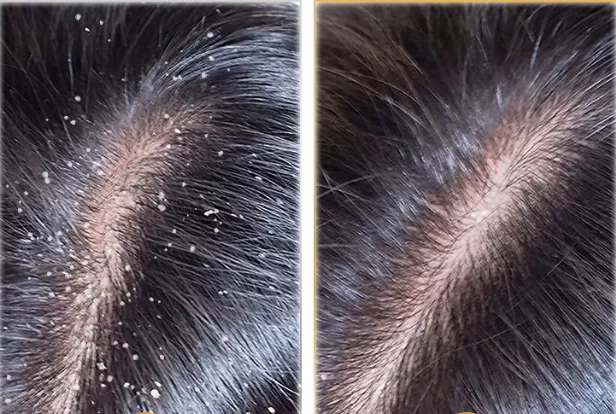Dandruff is a common scalp condition that affects millions worldwide, causing embarrassment and discomfort for those who suffer from it. While it may seem like a trivial issue, the impact of dandruff on self-esteem and confidence can be significant. With shelves overflowing with various anti-dandruff products, it can be challenging to determine which one is truly effective. In this article, we delve into the world of anti-dandruff solutions, separating fact from fiction and exploring the science behind effective treatments.
Understanding Dandruff: The Basics
Before delving into anti-dandruff solutions, it’s essential to understand what causes this pesky condition. Dandruff is primarily attributed to the overgrowth of a yeast-like fungus called Malassezia on the scalp. This fungus feeds on the natural oils produced by the scalp, leading to irritation and inflammation, which manifest as flaky skin.
Contrary to popular belief, dandruff is not solely caused by poor hygiene. While infrequent shampooing can contribute to the buildup of dead skin cells and oil on the scalp, other factors such as stress, hormonal changes, and certain medical conditions can also play a role.
The Anti-Dandruff Market: A Multimillion-Dollar Industry
With dandruff affecting such a large portion of the population, it’s no surprise that the market for anti-dandruff products is booming. From shampoos and conditioners to specialized treatments and scalp serums, there’s no shortage of options available to consumers.
However, not all anti-dandruff products are created equal. Many over-the-counter remedies contain active ingredients such as pyrithione zinc, selenium sulfide, ketoconazole, and coal tar, which work to combat the underlying causes of dandruff by targeting the Malassezia fungus and reducing inflammation.
Separating Fact from Fiction: Debunking Common Myths
In the quest for a dandruff-free scalp, it’s easy to fall prey to misinformation and myths surrounding this condition. Let’s debunk some of the most common misconceptions:
1. Myth: Dandruff is caused by dry scalp. While dry skin can contribute to flakiness, dandruff is primarily caused by the overgrowth of Malassezia fungus, not dryness. In fact, excessive washing and use of harsh shampoos can strip the scalp of its natural oils, exacerbating the problem.
2. Myth: Dandruff is contagious. Dandruff is not a contagious condition. It is caused by a combination of genetic predisposition, environmental factors, and the presence of Malassezia fungus on the scalp. However, certain skin conditions, such as seborrheic dermatitis, can mimic the symptoms of dandruff and may be contagious in rare cases.
3. Myth: Scratching the scalp worsens dandruff. While excessive scratching can lead to irritation and inflammation, it does not directly cause dandruff. However, scratching can exacerbate existing dandruff symptoms and lead to further discomfort.
By dispelling these myths, we can better understand the true nature of dandruff and take proactive steps towards effective treatment.
The Science of Anti-Dandruff Ingredients: What Works and Why
When it comes to choosing the right anti-dandruff product, it’s essential to look for ingredients backed by scientific research. Here are some of the most effective ingredients commonly found in anti-dandruff formulations:
1. Pyrithione Zinc: This antimicrobial agent effectively targets the Malassezia fungus, helping to reduce its population on the scalp and alleviate dandruff symptoms. It also has anti-inflammatory properties, making it an excellent choice for those with sensitive skin.
2. Ketoconazole: A powerful antifungal agent, ketoconazole inhibits the growth of Malassezia fungus and helps to alleviate itching and flaking associated with dandruff. It is often found in medicated shampoos and is available over the counter or by prescription.
3. Selenium Sulfide: This active ingredient works by slowing down the growth of skin cells on the scalp and reducing the production of oils that feed the Malassezia fungus. It is commonly found in anti-dandruff shampoos and can effectively control dandruff when used as directed.
4. Coal Tar: While its exact mechanism of action is not fully understood, coal tar has been used for decades to treat dandruff and other scalp conditions. It helps to reduce itching, flaking, and inflammation, making it a popular choice for those seeking relief from dandruff symptoms.
Conclusion: Choosing the Right Anti-Dandruff Solution
In conclusion, finding the perfect anti-dandruff solution requires a combination of scientific understanding, myth-busting, and a willingness to explore different ingredients and formulations. By choosing products containing proven active ingredients such as pyrithione zinc, ketoconazole, selenium sulfide, and coal tar, individuals can effectively manage dandruff and enjoy a healthier, happier scalp.
Remember, consistency is key when it comes to treating dandruff. Be patient, stick to a regular hair care routine, and consult a dermatologist if symptoms persist or worsen. With the right approach, you can banish dandruff and regain confidence in your hair and scalp health.


